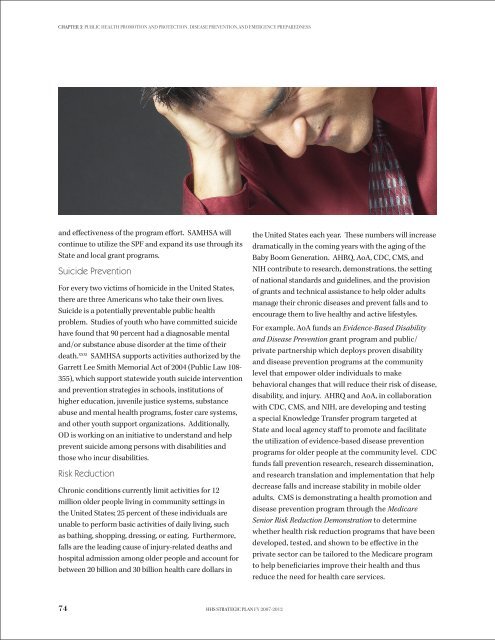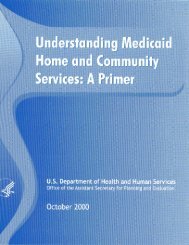STRATEGIC PLAN - ASPE - U.S. Department of Health and Human ...
STRATEGIC PLAN - ASPE - U.S. Department of Health and Human ...
STRATEGIC PLAN - ASPE - U.S. Department of Health and Human ...
Create successful ePaper yourself
Turn your PDF publications into a flip-book with our unique Google optimized e-Paper software.
CHAPTER 3: Public <strong>Health</strong> Promotion <strong>and</strong> Protection, Disease Prevention,<strong>and</strong> Emergency Preparedness<strong>and</strong> effectiveness <strong>of</strong> the program effort. SAMHSA willcontinue to utilize the SPF <strong>and</strong> exp<strong>and</strong> its use through itsState <strong>and</strong> local grant programs.Suicide PreventionFor every two victims <strong>of</strong> homicide in the United States,there are three Americans who take their own lives.Suicide is a potentially preventable public healthproblem. Studies <strong>of</strong> youth who have committed suicidehave found that 90 percent had a diagnosable mental<strong>and</strong>/or substance abuse disorder at the time <strong>of</strong> theirdeath. xxxi SAMHSA supports activities authorized by theGarrett Lee Smith Memorial Act <strong>of</strong> 2004 (Public Law 108-355), which support statewide youth suicide intervention<strong>and</strong> prevention strategies in schools, institutions <strong>of</strong>higher education, juvenile justice systems, substanceabuse <strong>and</strong> mental health programs, foster care systems,<strong>and</strong> other youth support organizations. Additionally,OD is working on an initiative to underst<strong>and</strong> <strong>and</strong> helpprevent suicide among persons with disabilities <strong>and</strong>those who incur disabilities.Risk ReductionChronic conditions currently limit activities for 12million older people living in community settings inthe United States; 25 percent <strong>of</strong> these individuals areunable to perform basic activities <strong>of</strong> daily living, suchas bathing, shopping, dressing, or eating. Furthermore,falls are the leading cause <strong>of</strong> injury-related deaths <strong>and</strong>hospital admission among older people <strong>and</strong> account forbetween 20 billion <strong>and</strong> 30 billion health care dollars inthe United States each year. These numbers will increasedramatically in the coming years with the aging <strong>of</strong> theBaby Boom Generation. AHRQ, AoA, CDC, CMS, <strong>and</strong>NIH contribute to research, demonstrations, the setting<strong>of</strong> national st<strong>and</strong>ards <strong>and</strong> guidelines, <strong>and</strong> the provision<strong>of</strong> grants <strong>and</strong> technical assistance to help older adultsmanage their chronic diseases <strong>and</strong> prevent falls <strong>and</strong> toencourage them to live healthy <strong>and</strong> active lifestyles.For example, AoA funds an Evidence-Based Disability<strong>and</strong> Disease Prevention grant program <strong>and</strong> public/private partnership which deploys proven disability<strong>and</strong> disease prevention programs at the communitylevel that empower older individuals to makebehavioral changes that will reduce their risk <strong>of</strong> disease,disability, <strong>and</strong> injury. AHRQ <strong>and</strong> AoA, in collaborationwith CDC, CMS, <strong>and</strong> NIH, are developing <strong>and</strong> testinga special Knowledge Transfer program targeted atState <strong>and</strong> local agency staff to promote <strong>and</strong> facilitatethe utilization <strong>of</strong> evidence-based disease preventionprograms for older people at the community level. CDCfunds fall prevention research, research dissemination,<strong>and</strong> research translation <strong>and</strong> implementation that helpdecrease falls <strong>and</strong> increase stability in mobile olderadults. CMS is demonstrating a health promotion <strong>and</strong>disease prevention program through the MedicareSenior Risk Reduction Demonstration to determinewhether health risk reduction programs that have beendeveloped, tested, <strong>and</strong> shown to be effective in theprivate sector can be tailored to the Medicare programto help beneficiaries improve their health <strong>and</strong> thusreduce the need for health care services.74 HHS Strategic Plan FY 2007-2012
















